|
|
||
| About Contact CV History |
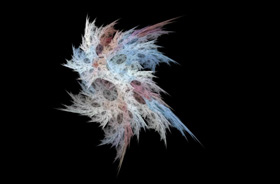
An early flame. 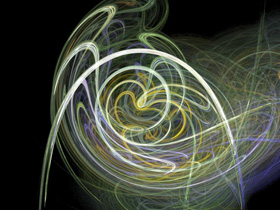
An early electric sheep. 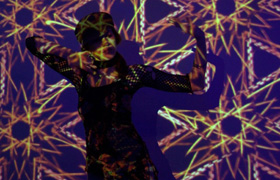
Projection on a dancer at Cyberarts 2007. Photo by Hannah Thiem 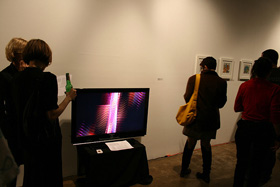
Dreams in High Fidelity showing at a gallery. 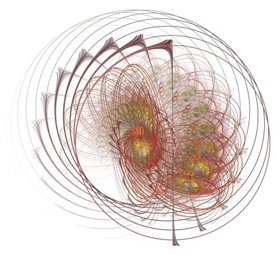
A rare white sheep. |
HistoryIn 1978, as a child, I encountered computers for the first time, and immediately fell in love. I badgered my parents until they bought me an Apple //e, and then went about teaching myself to program. I would entertain myself at home, alone in the dark, by writing graphics programs, and watching them run. The game was to get out more than I put in, or to somehow surprise myself. There's no fun in predictable or repetitive results. In 1991, at the age of 23 I spent the summer in Tokyo as an intern, working with an SGI supercomputer all to myself. For several years before I had been exploring iterated function systems in the graphics group at Brown University. I completed my job after a couple weeks and was given the rest of the summer to do as I pleased. Suddenly I was free to ask, how can I make the most beautiful result, without constraints of CPU power? How can I visualize and reveal all the information in the complex attractor? The resulting algorithm is a particle system that calculates the interference between geometric and non-linear transformations of the plane. The imagery of the Electric Sheep is composed from billions of tiny motes, much smaller than pixels, that reconfigure themselves to solve a recursive set equation with hundreds of parameters and millions of variables. It's a slow, but rewarding, algorithm. Unlike a lot of math art, the particles' colors are drawn from a palette, rather than a formula. And where did the palettes come from? I wrote an algorithm to extract and organize colors from any input image, then fed into it beautiful landscape photographs and old favorite painters like van Gogh and Klee. Now they come from lots of places, including many from the same algorithm. By this time I had become a life-long emacs junky, and had fallen in love again, this time with Free Software. And so next year, when the web arrived, I made a gallery of the nice images made with the algorithm from Japan and released the code under the GPL, the first open source art. There was no fanfare. But next year, a funny thing happened. I was a young grad student, getting a PhD in computer science at Carnegie Mellon. I was immersed in artificial intelligence, programming language theory, metaprogramming, robotics, and the Singularity. My advisor suggested I submit the "flame" images to the Prix Ars Electronica. I did, and received an Honorable Mention. Suddenly I was an artist. More importantly, I had the permission slip to pursue my dreams. The Flame renderer was ported into standard graphics tools such as Photoshop and After Effects, and used by other artists to make their own work. But I was busy... In 1997 I graduated and moved to the Bay Area of California. I left academia to seek my fortune in Silicon Valley, working with Linus Torvalds at a chip startup, Transmeta. |
|
One day I received a VHS tape in the mail. It was an animation made with the After Effects Flame plugin, and it impressed me because besides looking good, it was really long. The render time must have been enormous. Its creators worked at Alien Skin, a special effects company and had put the company's render farm to work after hours. Even with the fancy workstation I had from my job, it would have taken months to do something similar. A little later, in 1999, in the thick of the boom, I quit my job and had a month until the next one started. I took a vacation, I went to Burning Man, and I wrote and released the first Electric Sheep client/server. It was totally primitive, but it was distributed, after SETI@Home released earlier that year. All the computers running the screen-saver work together to form a virtual super-computer and render farm, animating the sheep. The clients render JPG frames and upload them to the server. The server compresses them into MPG video files, which are then downloaded and displayed by the clients for everyone to see. It was one of the first P2P networks, where the participants were the creators, rather than just consumers. The name "Electric Sheep" is an homage to the Philip K Dick science fiction novel "Do Androids Dream of Electric Sheep", the basis for the movie "Blade Runner". The metaphor is that to sleep, we count sheep. Your screen-saver comes on when your computer goes to sleep, and so the Electric Sheep are your computer's dream, the android dream. And not just your computer, but the computer, the machine, the network. As you watch you see a sequence of designs. Each design that appears is one sheep, a virtual creature with an artificial life. It's born, it lives, and it dies in the network and on everyone's screen. Each sheep has virtual DNA, which are the parameters that control how it looks and moves. As the years and versions went by, the network grew, attracted more users, and became more sophisticated. It went from distributed computing to distributed intelligence. So everyone who was watching could influence what they saw by voting. I adopted the Roman justice system: thumb up and thumb down. Life and death. The more popular sheep have sex and reproduce. The children have family resemblence and random variation. The result is the flock evolves, where the fitness function for the genetic algorithm is the desire of the human audience. It's profound that randomness, selection, and iteration can be responsible for the diversity and beauty of life of earth. The Electric Sheep are a vehicle to comprehending this. By 2001 the complexity of the sheep's genetic code had exceeded my understanding. I was getting bug reports and patches and adopting additions to the code from all over the world. There's now a team of about five engineers who make substantial contributions, plus an ever widening circle of one-off contributers. And then we added intelligent design. A new program was made based on my algorithm -- Apophysis, that anyone could download and use to play god. Anyone can edit the genome and see a thumbnail update in real time. When satisfied, upload the genome to the server where it joins the gene-pool. If it proves popular, it reproduces, and variations appear. So the artificial intelligence competes and collaborates with a human design team, Web 2.0 style. All the sheep are Creative Commons licensed, allowing anyone to improve or learn from anyone else's design. This also makes the genetic algorithm legal, since every mutation or cross-over creates a derived work. The philosophy of science and open-source is applied to art. Somewhere around 2002 I realized what was going on. The Electric Sheep had become a cyborg mind, fusing the collective intelligence of thousands of people with an algorithm into something new. As the network focuses attention onto the sheep, they became higher resolution and more complex. This mirrors the process by which the more attention you give an idea, the more detail and structure appears. I believe the free flow of code is an increasingly important social and artistic force. The proliferation of powerful computers with high bandwidth network connections forms the substrate of an expanding universe. The Electric Sheep and we their shepherds are colonizing this new frontier. In 2004 I was still living in San Francisco. The jobs had become less interesting and the sheep had become more interesting. The streams crossed, and I quit to do open-source art. My first plan was to perform live as a VJ with my software and sell DVDs with original material. It worked---but I was living in the ghetto, specifically, a loft in the Tenderloin. And though I was paying my rent, I had more expenses than rent. My savings were sinking. The dot com "fortune" wasn't going to do it. So was this an explosion of life, or a parasite, consuming my attention and resources to keep the server running and pay the bills? You see, there was a little problem. It turned out that having a robot army rendering for you is good, but having a robot army downloading videos from your server is expensive. We put in BitTorrent to share the bandwidth load like it already shared the computing load. But it only works for 1 in 10 users, and is often blocked outright, for political reasons. So was this an addiction to distraction that made me quit a promising and respectable career? Or could the sheep be made self-sustaining? Could the sheep be made profitable even, so they could grow and achieve their potential? Because of the bandwidth bottleneck, the network's render capacity was mostly idle. I realized I could put it to work rendering super-high resolution sheep. And then rather than distributing the results for free, on-line, sell them as limited edition fine art, hence turning the lemon of an overloaded server into the lemonade of a revenue stream. And so "Dreams in High Fidelity" was born. The result is a turnkey system, a computer loaded with hundreds of gigabytes of sheep and playback software to produce an endless, abstract, animation. Plug it into a projector or a framed, HD flat-screen and you have a "painting that evolves". Hundreds of CPU-years and untold human attention is distilled into a small black slab of electronics. You could call it "Art 2.0". Ironically, this concentrated life, these chosen sheep, have a negative space: all those that died or were eliminated along the way. They too are an essential part of the process. Even though they are not visible in the final product, their lineages, genomes, and still images of all the sheep are browsable online, forever. Besides smoother motion and higher resolution, aesthetically there's a fundamental difference between the HiFiDreams and the screen-saver: HiFidreams was edited and assembled by the artist. The public version suffers from what I originally called the "Las Vegas Effect" which is that the brightest, most colorful and fastest sheep get the most votes. By contrast, the HiFiDreams consists not of popular sheep, but those that satisfied me, the artist, personally and completely. Those that as a group, capture something beyond comprehension. The screen-saver is a design laboratory and idea fountain. The HiFiDreams is the final, distilled product. When these began to sell I realized that although San Francisco was a great place to make this art, New York City is the place to complete this art. By 2007 I was living in the Lower East Side of Manhattan. The dream had become real. The time is the present. The story has just begun. |
||
|
© 2008-2009 Spotworks LLC |
||